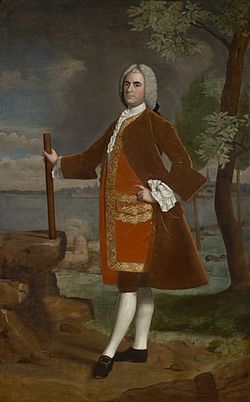Northeast Coast campaign (1746) facts for kids
Quick facts for kids Northeast Coast campaign (1746) |
|||||||
|---|---|---|---|---|---|---|---|
| Part of King George's War | |||||||
 Commander Samuel Waldo |
|||||||
|
|||||||
| Belligerents | |||||||
Wabanaki Confederacy |
|||||||
| Commanders and leaders | |||||||
| Commander Samuel Waldo (Falmouth) Captain Jonathan Williamson |
unknown | ||||||
| Strength | |||||||
| 625 | unknown | ||||||
| Casualties and losses | |||||||
| approximately 30 persons killed or captured | unknown | ||||||
The Northeast Coast campaign of 1746 was a series of attacks. It was carried out by the Wabanaki Confederacy from Acadia. They targeted New England settlements along the coast of what is now Maine. These attacks happened during King George's War, from July to September 1746.
The Wabanaki attacked English towns between Berwick and St. Georges (Thomaston, Maine). In just two months, there were nine raids. Every town on the frontier faced an attack. Casco, also known as Falmouth or Portland, was the main settlement.
Why Did the Conflict Happen?
This campaign was part of a larger conflict called King George's War. After two attacks on Annapolis Royal in 1744, Governor William Shirley offered rewards. These rewards were for capturing members of the Passamaquoddy, Mi’kmaq, and Maliseet tribes.
The next year, in August 1745, Governor Shirley declared war. This was against the Penobscot and Kennebec tribes. These tribes were also part of the Wabanaki Confederacy.
New England had attacked Louisbourg in June 1745. In response, the Wabanaki Confederacy began attacking the New England border. New England prepared for these attacks. They set up a force of 450 soldiers to defend the frontier.
After the attacks started, they added 175 more soldiers. Massachusetts built forts along the border with Acadia. These included Fort George at Brunswick (built in 1715) and St. George's Fort at Thomaston (1720). They also built Fort Richmond at Richmond (1721). Fort Frederick was built at Pemaquid (Bristol, Maine).
After the 1745 campaign, more British troops arrived. 200 soldiers came in January, and 460 more in the spring. They were sent to the New England/Acadia border.
Key Events of the Campaign
The 1746 campaign began on April 19. Ten native militia members raided Gorhamtown. Gorham had a blockhouse and four families living there. The attackers split into five groups of two. They attacked the four families at the same time. Some family members were killed, and others were taken captive.
The men in the blockhouse chased the attackers. One of the militia members was captured.
Next, the Confederacy raided what is now Waldoboro, Maine. They burned the village and captured some people. Others fled to Pemaquid or St. Georges. The villagers did not return until after the war ended.
The Confederacy also raided Pemaquid, where they killed cattle.
A group of 15 native men ambushed five people at Sheepscot. This is now Newcastle, Maine. One person was killed. A villager managed to kill one of the attackers.
At Wiscasset, Maine, attackers killed 19 cattle. They also captured Captain Jonathan Williamson, holding him for six months.
There was a battle near Fort St. Georges at Thomaston. One native was killed and another was wounded there.
A group of 30 natives was seen near Falmouth and North Yarmouth, Maine. They killed two people near Long-creek (Stroudwater). Soldiers from New Casco Fort approached. The natives then moved to attack Frost’s fortified house at Stroudwater. However, it was strongly defended. Another blockhouse was built for protection.
At Scarborough, Maine, the natives killed a soldier and several other people.
The last attack happened on August 26 near Pemaquid, close to Fort Frederick. Attackers destroyed a settler's cattle and home. The owner and his son were wounded.
What Happened After the Campaign?
After these events, Governor Shirley sent more troops and supplies to the Maine frontier. This happened over the winter. He expected more attacks from the Wabanaki in the spring of 1747.
In response, St. Georges was protected by 30 men. A force of 370 men was placed between Berwick and Damariscotta. 150 of these were "minute-men," ready to act quickly. Rewards for capturing enemies were increased to encourage more defense.

